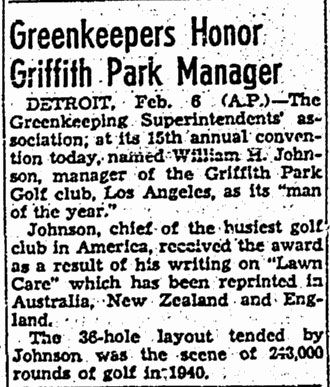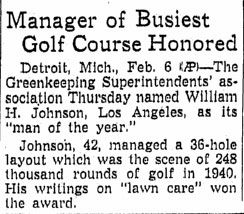Thanks Joe, That is the article to which I was referring. It lists days with rounds for 933, 924, 910, and 864 golfers, so it seems it is obviously talking about more than one course. Likewise with the number of 127K+ rounds per year. Given Philadelphia weather it would seem to be a doubtful number for a single course. Taking out the 19 "blank" days, that would mean an average of 367 golfers per day, and this doesn't take into consideration days where some golfed but the play was light due to short days, bad weather, or other circumstances. For example, 1930 was the busiest January yet, but an average of only 88 golfers per day played, and that figure may have been for both courses! (I see Patrick did similar analysis].
Sure these numbers could be for both courses, but all that really matters IMO is an insanely high number of rounds were played there.
I agree with you that it was a very busy course. That said, I think your sentiment expressed here might get to the heart of our methodological and epistemological differences. While the "insanely high number of rounds"
* certainly matters so does historical accuracy. If the course was very busy (I have no doubt it was) and you guys want to emphasize this,
there must be a way to do so using accurate and unexaggerated information. After all, you guys make these claims as
if they are fact:
"In fact . . . [rounds] grew to to an incredible 120,000 rounds by 1929. Even as late as 1940, Cobb's had more rounds than any other public course in the country."(p.5)
Speaking of the 1940 numbers, I have asked you a number of times for the support of for your claim that Cobb's was the busiest course in the country for 1940 but you haven't answered. As I said when I first brought this up, I figured it would be a course with better year 'round weather, and that I had seen similar claims for the similar time period for Southern California courses. Since you don't seem inclined to provide me the support, today I did a quick search and came up with the following A.P. articles, versions of which appeared in various papers across the country in February 1941. The articles happen to address the year, 1940.


That amount (an average of 124,000 for each of the two 18 hole courses) sounds about right for Griffith Park during this earlier time period, when, as Dale Jackson points out, play was a bit faster. The year round weather here is usually a bit more accommodating than in Philadelphia.
The first A.P. article mentioned Griffith Park is the "busiest club" in the in America. The second mentioned "busiest course." To know whether they are using the number for both courses or the number per course we'd have to see the press release from the National Superintendents Assn. But I've seen other references to one or both of these courses as being the busiest during this general time period as well, and whether one of the Griffith courses was busiest or not, I suspect it was somewhere with a large population and similar weather.
Any chance you will come up with the support for your claim that it was Cobb's? Thanks.
* I really don't want to argue about it, but is 127,000 rounds for two courses really an "insanely" high number of rounds? Likewise regarding an average of 60,000 rounds per year. If that Griffith Park number is accurate, then Cobb's numbers would seem pretty pretty manageable for courses out here, but then I come back to my initial assumption that Southern California has many more golfing days. Maybe D. Malley can give us an idea of what is considered a very busy year for a public course in that region.
What a dubious distinction for the perspective of a public golfer. We want our courses to be good, but hope they aren't that busy. The current "busiest" course champion (yuck) is supposedly Ali Wai Municipal in near Waikiki Beach, at least according to the Guinness Book of World's Records, as reported in a Frommer's review.